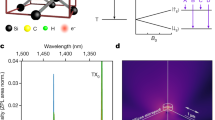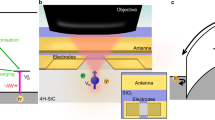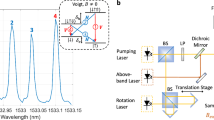Abstract
Quantum networking and computing technologies demand scalable hardware with high-speed control for large systems of quantum devices. Solid-state platforms have emerged as promising candidates, offering scalable fabrication for a wide range of qubits. Architectures based on spin–photon interfaces allow for highly connected quantum networks over photonic links, enabling entanglement distribution for quantum networking and distributed quantum computing protocols. With the potential to address these demands, optically active spin defects in silicon are one proposed platform for building quantum technologies. Here we electrically excite the silicon T centre in integrated optoelectronic devices that combine nanophotonic waveguides and cavities with p–i–n diodes. We observe single-photon electroluminescence from a cavity-coupled T centre with g(2)(0) = 0.05(2). Further, we use the electrically triggered emission to herald the electron spin state, initializing it with 92(8)% post-selected fidelity. This shows electrically injected single-photon emission from a silicon colour centre and a new method of heralded spin initialization with electrical excitation. These findings present a new telecommunications-band light source for silicon and a highly parallel control method for T centre quantum processors, advancing the T centre as a versatile defect for scalable quantum technologies.
This is a preview of subscription content, access via your institution
Access options
Access Nature and 54 other Nature Portfolio journals
Get Nature+, our best-value online-access subscription
$32.99 / 30 days
cancel any time
Subscribe to this journal
Receive 12 print issues and online access
$259.00 per year
only $21.58 per issue
Buy this article
- Purchase on SpringerLink
- Instant access to full article PDF
Prices may be subject to local taxes which are calculated during checkout



Similar content being viewed by others
Data availability
The data that support this work are available from the corresponding author upon reasonable request.
References
Simmons, S. Scalable fault-tolerant quantum technologies with silicon color centers. PRX Quantum 5, 010102 (2024).
Awschalom, D. D., Hanson, R., Wrachtrup, J. & Zhou, B. B. Quantum technologies with optically interfaced solid-state spins. Nat. Photon. 12, 516 (2018).
Yu, Y. et al. Telecom-band quantum dot technologies for long-distance quantum networks. Nat. Nanotechnol. 18, 1389 (2023).
Yin, C. et al. Optical addressing of an individual erbium ion in silicon. Nature 497, 91 (2013).
Pompili, M. et al. Realization of a multinode quantum network of remote solid-state qubits. Science 372, 259 (2021).
Castelletto, S. & Boretti, A. Silicon carbide color centers for quantum applications. J. Phys.: Photon. 2, 022001 (2020).
Bergeron, L. et al. Silicon-integrated telecommunications photon-spin interface. PRX Quantum 1, 020301 (2020).
Higginbottom, D. B. et al. Optical observation of single spins in silicon. Nature 607, 266 (2022).
Johnston, A., Felix-Rendon, U., Wong, Y.-E. & Chen, S. Cavity-coupled telecom atomic source in silicon. Nat. Commun. 15, 2350 (2024).
Xiong, Y. et al. Computationally driven discovery of T center-like quantum defects in silicon. J. Am. Chem. Soc. 146, 30046 (2024).
Higginbottom, D. B. et al. Memory and transduction prospects for silicon T center devices. PRX Quantum 4, 020308 (2023).
Afzal, F. et al. Distributed quantum computing in silicon. Preprint at https://arxiv.org/abs/2406.01704 (2024).
Shekhar, S. et al. Roadmapping the next generation of silicon photonics. Nat. Commun. 15, 751 (2024).
Stockill, R. et al. Phase-tuned entangled state generation between distant spin qubits. Phys. Rev. Lett. 119, 010503 (2017).
Hofmann, J. et al. Heralded entanglement between widely separated atoms. Science 337, 72 (2012).
Drmota, P. et al. Verifiable blind quantum computing with trapped ions and single photons. Phys. Rev. Lett. 132, 150604 (2024).
Knaut, C. M. et al. Entanglement of nanophotonic quantum memory nodes in a telecom network. Nature 629, 573 (2024).
MacQuarrie, E. R. et al. Generating T centres in photonic silicon-on-insulator material by ion implantation. New J. Phys. 23, 103008 (2021).
DeAbreu, A. et al. Waveguide-integrated silicon T centres. Opt. Express 31, 15045 (2023).
Lee, C.-M. et al. High-efficiency single photon emission from a silicon T-center in a nanobeam. ACS Photon. 10, 3844 (2023).
Islam, F. et al. Cavity-enhanced emission from a silicon T center. Nano Lett. 24, 319 (2023).
Dhaliah, D., Xiong, Y., Sipahigil, A., Griffin, S. M. & Hautier, G. First-principles study of the T center in silicon. Phys. Rev. Mater. 6, L053201 (2022).
Clear, C. et al. Optical-transition parameters of the silicon T center. Phys. Rev. Appl. 22, 064014 (2024).
Anderson, C. P. et al. Electrical and optical control of single spins integrated in scalable semiconductor devices. Science 366, 1225 (2019).
de las Casas, C. F. et al. Stark tuning and electrical charge state control of single divacancies in silicon carbide. Appl. Phys. Lett. 111, 262403 (2017).
Cadiz, F. et al. Electrical initialization of electron and nuclear spins in a single quantum dot at zero magnetic field. Nano Lett. 18, 2381 (2018).
Lohrmann, A. et al. Single-photon emitting diode in silicon carbide. Nat. Commun. 6, 7783 (2015).
Widmann, M. et al. Electrical charge state manipulation of single silicon vacancies in a silicon carbide quantum optoelectronic device. Nano Lett. 19, 7173 (2019).
Rieger, M. et al. Fast optoelectronic charge state conversion of silicon vacancies in diamond. Sci. Adv. 10, eadl4265 (2024).
Niethammer, M. et al. Coherent electrical readout of defect spins in silicon carbide by photo-ionization at ambient conditions. Nat. Commun. 10, 5569 (2019).
Siyushev, P. et al. Photoelectrical imaging and coherent spin-state readout of single nitrogen-vacancy centers in diamond. Science 363, 728 (2019).
Buckley, S. et al. All-silicon light-emitting diodes waveguide-integrated with superconducting single-photon detectors. Appl. Phys. Lett. 111, 141101 (2017).
Ebadollahi, N. et al. Fabrication of silicon W and G center embedded light-emitting diodes for electroluminescence. J. Vac. Sci. Technol. B 42, 062208 (2024).
Day, A. M. et al. Electrical manipulation of telecom color centers in silicon. Nat. Commun. 15, 4722 (2024).
Chartrand, C. et al. Highly enriched 28Si reveals remarkable optical linewidths and fine structure for well-known damage centers. Phys. Rev. B 98, 195201 (2018).
Marchetti, R. et al. High-efficiency grating-couplers: demonstration of a new design strategy. Sci. Rep. 7, 16670 (2017).
Quan, Q. & Loncar, M. Deterministic design of wavelength scale, ultra-high Q photonic crystal nanobeam cavities. Opt. Express 19, 18529 (2011).
Irion, E., Burger, N., Thonke, K. & Sauer, R. The defect luminescence spectrum at 0.9351 eV in carbon-doped heat-treated or irradiated silicon. J. Phys. C Solid State Phys. 18, 5069 (1985).
Davies, G. The optical properties of luminescence centres in silicon. Phys. Rep. 176, 83 (1989).
Bowness, C. et al. Laser-induced spectral diffusion and excited-state mixing of silicon T centres. Preprint at https://arxiv.org/abs/2504.09908 (2025).
Zhang, X. et al. Laser-induced spectral diffusion of T centers in silicon nanophotonic devices. Preprint at https://arxiv.org/abs/2504.08898 (2025).
Komza, L. et al. Indistinguishable photons from an artificial atom in silicon photonics. Nat. Commun. 15, 6920 (2024).
Ivanov, V. et al. Effect of localization on photoluminescence and zero-field splitting of silicon color centers. Phys. Rev. B 106, 134107 (2022).
Laccotripes, P. et al. Spin-photon entanglement with direct photon emission in the telecom C-band. Nat. Commun. 15, 9740 (2024).
Kok, P. et al. Linear optical quantum computing with photonic qubits. Rev. Mod. Phys. 79, 135 (2007).
Van Dam, W., Mykhailova, M. & Soeken, M. Reversible logic synthesis via symbolic reachability analysis. In Proc. SC ’23 Workshops of the International Conference on High Performance Computing, Network, Storage, and Analysis 1414–1419 (ACM, 2023).
Zheng, J. et al. An on-chip photon-counting reconstructive spectrometer with tailored cascaded detector array. Adv. Devices Instrum. 4, 0021 (2023).
Bohuslavskyi, H. et al. Scalable on-chip multiplexing of silicon single and double quantum dots. Commun. Phys. 7, 323 (2024).
Day, A. M. et al. Probing negative differential resistance in silicon with a P-I-N diode-integrated T center ensemble. Preprint at https://arxiv.org/abs/2501.11888 (2025).
Ziegler, J. F., Ziegler, M. D. & Biersack, J. P. SRIM—the stopping and range of ions in matter (2010). Nucl. Instrum. Methods Phys. Res. B 268, 1818–1823 (2010).
Bogaerts, W., Dumon, P., Thourhout, D. V. & Baets, R. Low-loss, low-cross-talk crossings for silicon-on-insulator nanophotonic waveguides. Opt. Lett. 32, 2801 (2007).
Beveratos, A. et al. Room temperature stable single-photon source. Eur. Phys. J. D 18, 191 (2002).
Laferriére, P. et al. Position-controlled telecom single photon emitters operating at elevated temperatures. Nano Lett. 23, 962 (2023).
Acknowledgements
We thank the Integrated Photonics team at Photonic Inc. for their contributions to the design and fabrication of the silicon chip presented in this work. This work was supported by the Natural Sciences and Engineering Research Council of Canada (NSERC), the New Frontiers in Research Fund (NFRF), the Canada Research Chairs program (CRC), the Canada Foundation for Innovation (CFI), the B.C. Knowledge Development Fund (BCKDF), the Quantum Information Science program at the Canadian Institute for Advanced Research (CIFAR), and Photonic Inc. S.A.M. acknowledges support from NSERC (PDF-587831-2024). S.S. is supported by the Arthur B. McDonald Fellowship.
Author information
Authors and Affiliations
Contributions
M.D., S.S. and D.B.H. designed the experiment. M.D. and F.A. designed the samples used in the study. I.M. and N.J. fabricated the samples. C.C. assisted in conceiving the experiment and device design. M.D., C.B., S.A.M. and M.G. built the measurement apparatus. M.D., S.A.M. and E.H. measured the diode characteristics. M.D. measured the EL, lifetime, photon correlations and spin initialization SPAM fidelity. S.A.M., C.D. and M.L.W.T. advised on design and analysis. All authors participated in preparation of the manuscript.
Corresponding author
Ethics declarations
Competing interests
M.D., C.B., S.A.M., C.C., M.G., I.M., F.A., C.D., N.J., S.S. and D.B.H are current or recent employees of and/or have a financial interest in Photonic Inc., a quantum technology company. C.B., C.C., I.M., F.A., C.D., N.J., M.L.W.T., S.S. and D.B.H. have a financial interest in Photonic Inc. E.H. declares no competing interests.
Peer review
Peer review information
Nature Photonics thanks Fedor Jelezko and the other, anonymous, reviewer(s) for their contribution to the peer review of this work.
Additional information
Publisher’s note Springer Nature remains neutral with regard to jurisdictional claims in published maps and institutional affiliations.
Supplementary information
Supplementary Information
Supplementary Sections I–VII, Figs. 1–14 and Tables 1–7.
Rights and permissions
Springer Nature or its licensor (e.g. a society or other partner) holds exclusive rights to this article under a publishing agreement with the author(s) or other rightsholder(s); author self-archiving of the accepted manuscript version of this article is solely governed by the terms of such publishing agreement and applicable law.
About this article
Cite this article
Dobinson, M., Bowness, C., Meynell, S.A. et al. Electrically triggered spin–photon devices in silicon. Nat. Photon. 19, 1132–1137 (2025). https://doi.org/10.1038/s41566-025-01752-8
Received:
Accepted:
Published:
Issue date:
DOI: https://doi.org/10.1038/s41566-025-01752-8
This article is cited by
-
Spin–photon interfaces in silicon
Nature Photonics (2025)



